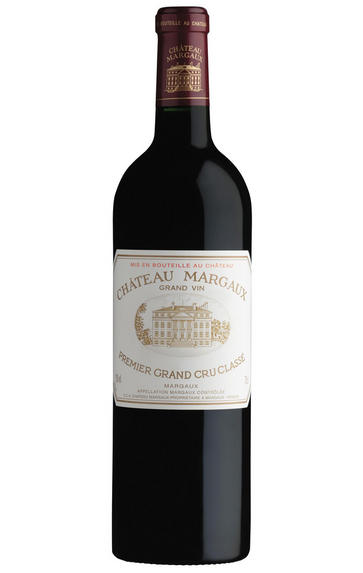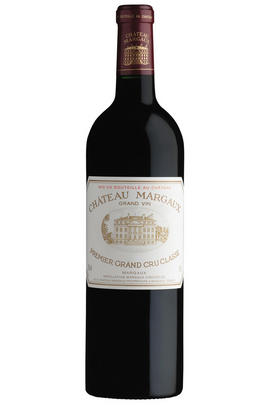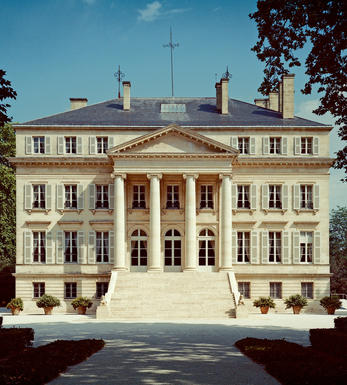
2009 Château Margaux, Margaux, Bordeaux

Critics reviews
Tasted blind at Farr Vintners’ 2009 Bordeaux tasting.
The 2009 Château Margaux is intense and powerful on the nose with blackberry, forest floor, graphite and rose petals that unfurl with aeration. The palate is medium-bodied with fine grain tannin, impressive density and plenty of freshness, perhaps more than the 2009 Mouton-Rothschild. There is a genuine Pauillac-like drive to this Château Margaux thanks to the Cabernet Sauvignon, clearly a First Growth destined for long-term ageing. 13.1% alcohol.
Drink 2023 - 2070
Neal Martin, Vinous.com (March 2019)
A blend of 87% Cabernet Sauvignon, 9% Merlot, 2% Cabernet Franc and 2% Petit Verdot; pH 3.79; 13.3% alcohol; represents a stringent 36% selection.
Good full ruby-red. Pure, ripe aromas of cassis, graphite and cedar, lifted by floral and mineral high notes. Dense and amazingly concentrated yet light on its feet, with compelling, extremely pure flavours of spicy blackcurrant, tobacco leaf and minerals. The extremely long, slow-building and wonderfully fine-grained finish offers an exhilarating combination of power and sweetness. This comes across as quite backward today yet is anything but austere. A real essence of Margaux's great terroir, and one of my favourite wines of the vintage.
As I walked to the parking lot with Pontallier after the tasting, he said to me, "If people don't think this is one of the greatest wines I have ever made, then it means I haven't really understood anything in the last 30 years spent making wine."
Ian D'Agata, Vinous.com (May 2010)
100% new oak. 31% of production won the 1st wine, with the same high level of Cabernet Sauvignon as in 2005. Paul Pontallier director in these years, and this continues to set out a benchmark for the property, as it has every time I have tasted it.
Power and enveloping aromatics from the first moment, this is bursting with pleasure, and so signature Margaux. Impossible not to love the depth and the spice that comes through from the first moment, with spirals of sandalwood, violets, crushed raspberries and cassis. Enticing generous, and totally delicious. Still young, very much in its primary fruit phase, but you can begin to drink this now, such is the vibrancy of the tannins, but it will deliver for many decades to come. Torreified, smoked coffee bean and campfire notes overtake after half an hour in the glass.
Drink 2022 - 2050
Jane Anson, JaneAnson.com (July 2022)
The 2009 Château Margaux is deep garnet in colour and features wonderfully fragrant minted cassis, lilacs, Black Forest cake and oolong tea scents with touches of pencil shavings and dusty soil. Medium to full-bodied, it has a firm, grainy frame with lovely freshness lifting the perfumed fruit to a very long, mineral-laced finish.
Drink 2020 - 2050
Lisa Perrotti-Brown, Wine Advocate (March 2019)
Tasted blind. Dark lustrous crimson. Spicy note and very ripe fruit with some leafiness. Thick and sweet – very rich and fat. Very dramatic. Group average placed this second favourite of the 2009s.
Drink 2020 - 2055
Jancis Robinson MW, JancisRobinson.com (March 2019)
This marathon runner is currently in the no-man's land between youthful vitality and mellow maturity. There's a very serious tannin structure here, but it needs a lot longer to fully resolve. Very tight and closed. A perfect wine usually. But not today.
Try in 2020
James Suckling, JamesSuckling.com (October 2019)
A brilliant offering from the Mentzelopoulos family, once again their gifted manager, Paul Pontallier, has produced an uncommonly concentrated, powerful 2009 Chateau Margaux made from 87% Cabernet Sauvignon and the rest primarily Merlot with small amounts of Cabernet Franc and Petit Verdot. As with most Medocs, the alcohol here is actually lower (a modest 13.3%) than most of its siblings.
Abundant blueberry, cassis and acacia flowers as well as hints of charcoal and forest floor aromas that are almost Burgundian in their complexity are followed by a wine displaying sweet, well-integrated tannins as well as a certain ethereal lightness despite the wine's overall size. Rich, round, generous and unusually approachable for such a young Margaux, this 2009 should drink well for 30-35+ years.
Drink 2012 - 2047
Robert M. Parker, Jr., Wine Advocate (December 2011)
1.5% Cabernet Franc completes the blend.
A winning combination of power and elegance here, showcasing the concentration of the year in the full, ripe and muscular fruit and tannins balanced by racy acidity and supreme tension making this a wonderful wine to taste and drink. It's ample and generous, giving tons of flavour nuance - black berry fruits, subtle sweet spice, cocoa powder and graphite as well as textural interest. It also has excellent markers of terroir in the mineral salinity that lingers on the finish. You get a sense of hidden strength here too, there's depth and layering but also a grace to the overall frame with a juiciness that is so joyful. Energetic, lively and expressive and all very harmonious. What a wine.
Drink 2022 - 2055
Georgina Hindle, Decanter.com (June 2022)
About this WINE

Chateau Margaux
Château Margaux, a First Growth property, has been owned by the Mentzelopoulos family since 1978. It has since consistently produced some of the finest wines in the Médoc.
One of the grandest, most imposing buildings amongst the Médoc châteaux, Ch. Margaux in its current form was built in the early 19th century, although viticulture had been practised on the estate for several centuries before. A chequered period of ownership in the 19th and early 20th century meant that the quality of some vintages was patchy. But the change which restored the property to its rightful status came in 1977 when it was bought by André Mentzenopoulos, Greek by birth but who had lived in France since 1958 and had made a fortune through supermarket retailing. André immediately instigated much-needed investment in vineyard and cellar. His untimely death in 1980 saw his daughter, Corinne, take up the reins. Corinne’s shrewdest move was the recruitment of talented young winemaker Paul Pontallier to oversee the production.
Paul would lead the estate for 33 vintages. He sadly passed away in 2016. Today, the estate is overseen by director Philippe Bascaules and technical director Sebastien Vergne, working with consultant Eric Boissenot.
The estate has 82 hectares under vine, with Cabernet Sauvignon inevitably dominant (75%) with 20% Merlot making up most of the rest, along with a smattering of Cabernet Franc and Petit Verdot. Unusually in Margaux, there is a white wine made here, Pavillon Blanc, from 100% Sauvignon Blanc, while the two red wines are, of course, Ch. Margaux itself and Pavillon Rouge. Typically, about 30,000 cases of red wine are made, with the Grand Vin usually accounting for just over 40% of the total. Production of the white wine amounts to less than 3,000 cases.
Margaux wines are renowned for their perfumed elegance, but this should not be construed as meaning that these are light-bodied. Far from it, as the best have an enviable structure, layers of complexity, and formidable length.

Margaux
If Pauillac can be seen as the bastion of ‘traditional’ Red Bordeaux, then Margaux represents its other facet in producing wines that are among Bordeaux’s most sensual and alluring. It is the largest commune in the Médoc, encompassing the communes of Cantenac, Soussans, Arsac and Labaude, in addition to Margaux itself. Located in the centre of the Haut-Médoc, Margaux is the closest of the important communes to the city of Bordeaux.
The soils in Margaux are the lightest and most gravelly of the Médoc, with some also containing a high percentage of sand. Vineyards located in Cantenac and Margaux make up the core of the appelation with the best vineyard sites being located on well-drained slopes, whose lighter soils give Margaux its deft touch and silky perfumes. Further away from the water, there is a greater clay content and the wines are less dramatically perfumed.
Margaux is the most diffuse of all the Médoc appelations with a reputation for scaling the heights with irreproachable wines such as Ch. Margaux and Ch. Palmer, but also plumbing the depths, with too many other châteaux not fulfilling their potential. There has been an upward shift in recent years, but the appellation cannot yet boast the reliability of St Julien. However, the finest Margaux are exquisitely perfumed and models of refinement and subtlety which have few parallels in Bordeaux.
Recommended Châteaux: Ch. Margaux, Ch. Palmer, Ch. Brane-Cantenac, Ch. Rauzan-Ségla , Ch. Dufort-Vivens, Ch. Ferrière, Ch. du Tertre, Ch. Giscours, Ch. d'Angludet.

Cabernet Sauvignon Blend
Cabernet Sauvignon lends itself particularly well in blends with Merlot. This is actually the archetypal Bordeaux blend, though in different proportions in the sub-regions and sometimes topped up with Cabernet Franc, Malbec, and Petit Verdot.
In the Médoc and Graves the percentage of Cabernet Sauvignon in the blend can range from 95% (Mouton-Rothschild) to as low as 40%. It is particularly suited to the dry, warm, free- draining, gravel-rich soils and is responsible for the redolent cassis characteristics as well as the depth of colour, tannic structure and pronounced acidity of Médoc wines. However 100% Cabernet Sauvignon wines can be slightly hollow-tasting in the middle palate and Merlot with its generous, fleshy fruit flavours acts as a perfect foil by filling in this cavity.
In St-Emilion and Pomerol, the blends are Merlot dominated as Cabernet Sauvignon can struggle to ripen there - when it is included, it adds structure and body to the wine. Sassicaia is the most famous Bordeaux blend in Italy and has spawned many imitations, whereby the blend is now firmly established in the New World and particularly in California and Australia.


Buying options
Add to wishlist
Description
This was the first First Growth on the Left Bank we tasted in 2009 and it was magnificent. With an intense, lifted, floral perfume and a succulent palate of mulberries, blackcurrant and fruitcake spice this is massively concentrated whilst somehow managing to feel very understated. The tannins are of the highest level ever recorded at Margaux but skip lightly across the palate and then just melt away. With its elegant minerality, sweet ripe fruit and extraordinary length, this is a truly lovely wine.
Berry Bros. & Rudd
wine at a glance
Delivery and quality guarantee